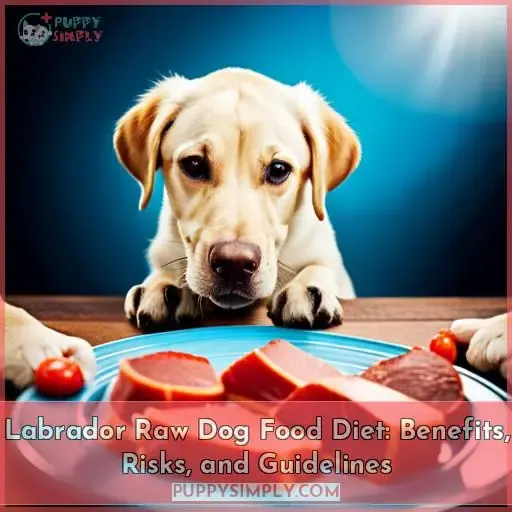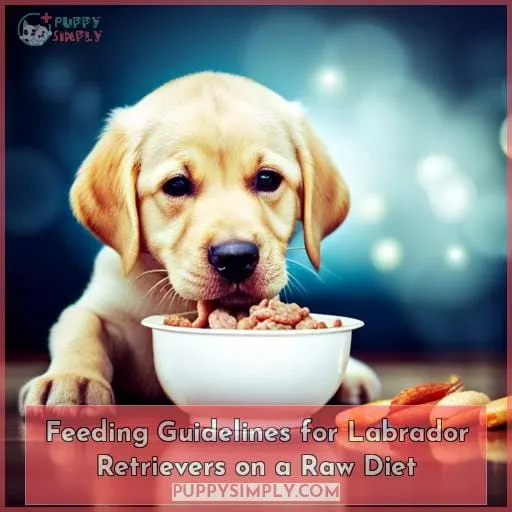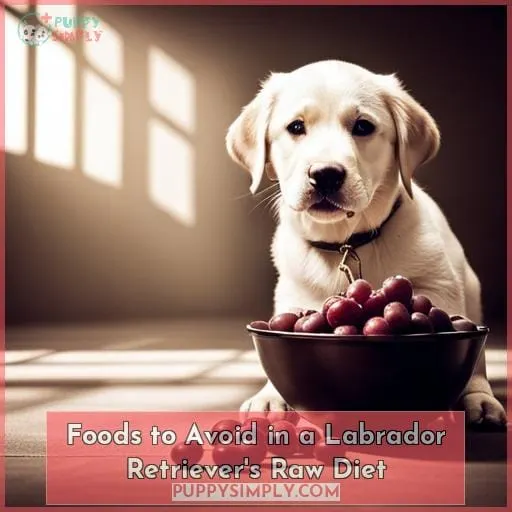This site is supported by our readers. We may earn a commission, at no cost to you, if you purchase through links.
 Imagine if you could unlock the secret to improving your Labrador’s health and vitality. Well, look no further than a raw dog food diet. By feeding your beloved pup a natural, protein-rich diet, you can provide them with numerous benefits such as better dental health and improved stool consistency.
Imagine if you could unlock the secret to improving your Labrador’s health and vitality. Well, look no further than a raw dog food diet. By feeding your beloved pup a natural, protein-rich diet, you can provide them with numerous benefits such as better dental health and improved stool consistency.
But before diving in headfirst, it’s important to understand the risks and guidelines associated with this approach. In this article, we’ll explore everything you need to know about the Labrador raw dog food diet for ultimate canine well-being.
Table Of Contents
- Key Takeaways
- Benefits of a Raw Diet for Labrador Retrievers
- Risks and Safety Considerations of a Raw Diet for Labrador Retrievers
- Nutritional Guidelines for a Labrador Retriever’s Raw Diet
- Feeding Guidelines for Labrador Retrievers on a Raw Diet
- Raw Diet for Labrador Retriever Puppies
- Cooking, Handling, and Serving Tips for Raw Dog Food
- Transitioning Your Labrador Retriever to a Raw Diet
- Foods to Avoid in a Labrador Retriever’s Raw Diet
- Comparing Raw Diet and Kibble for Labrador Retrievers
- Frequently Asked Questions (FAQs)
- Can a raw diet for Labrador Retrievers help with specific health conditions or allergies?
- Are there any specific guidelines for feeding senior Labrador Retrievers on a raw diet?
- How can I ensure that my Labrador Retriever is getting all the necessary nutrients on a raw diet?
- What are some common mistakes to avoid when transitioning a Labrador Retriever to a raw diet?
- What are the potential benefits and drawbacks of feeding a Labrador Retriever a raw diet compared to a kibble diet in terms of cost and convenience?
- Conclusion
Key Takeaways
- Improved dental health and reduced risk of bloat
- Proper balance of calcium, phosphorus, and nutrients
- Importance of including organ meats in the diet
- Guidelines for feeding and transitioning to a raw diet for Labrador Retrievers
Benefits of a Raw Diet for Labrador Retrievers
Switching your Labrador Retriever to a raw diet can provide several benefits.
One of the main advantages is improved dental health, as chewing on bones and raw meat helps clean their teeth naturally.
Additionally, a raw diet may reduce the risk of bloat, a potentially life-threatening condition that commonly affects large breed dogs like Labradors.
Another benefit is improved stool consistency, which can help prevent anal gland issues and make cleanup easier for you.
Dental benefits of raw diet
A raw diet for Labrador Retrievers can provide significant dental benefits, helping to maintain strong teeth and gums.
Chewing bones in a raw diet helps clean teeth by reducing plaque and tartar buildup.
The act of chewing stimulates the gums, promoting healthier gum tissue.
Additionally, the natural calcium found in bones contributes to better bone health overall.
By incorporating a raw diet into your Labrador’s routine, you can reduce the risk of oral diseases and ensure stronger teeth for your furry friend.
Reduced risk of bloat
By feeding your Labrador Retriever a raw diet, you can reduce their risk of experiencing bloat.
Bloat is a life-threatening condition where the stomach fills with gas and twists on itself.
Raw diets are low in carbohydrates, which helps prevent the excessive gas production that can lead to bloat.
Additionally, raw diets promote better digestion and improved stool consistency, resulting in less odorous feces and overall better gastrointestinal health for your Labrador.
Retrieved 15:09
Improved stool consistency
When feeding your Labrador Retriever a raw diet, you can expect to see:
- Improved stool consistency.
- Raw food diets are more easily digested by dogs, resulting in firmer and less odorous feces.
- This not only makes cleanup easier for you but also indicates that your dog’s digestive system is functioning optimally.
- Improved stool consistency can also lead to fewer anal gland issues and healthier teeth.
- Additionally, a raw diet provides mental stimulation through chewing, reducing boredom in your Labrador Retriever.
Risks and Safety Considerations of a Raw Diet for Labrador Retrievers
When considering a raw diet for your Labrador Retriever, it’s important to be aware of the potential risks and safety considerations.
One risk is the potential bacterial contamination that can come from handling and consuming raw meat.
Another consideration is the risk of intestinal blockage if large bone fragments are ingested without proper chewing.
Lastly, ensuring a balanced nutrient intake is crucial to avoid deficiencies or imbalances in your dog’s diet.
Potential bacterial contamination
To ensure the safety of your Labrador Retriever’s raw diet, it’s important to be aware of the potential risks associated with bacterial contamination.
- Practice safe handling practices when preparing and serving raw food.
- Store raw food properly in a separate area from other foods to prevent cross-contamination.
- Be aware of the risk of salmonella, listeria, and E.coli contamination in raw meat.
- Regularly clean and disinfect bowls, utensils, and surfaces used for feeding your dog‘s raw diet.
By following these guidelines, you can minimize the risk of bacterial contamination in your Labrador Retriever’s raw diet while ensuring their health and well-being.
Risk of intestinal blockage
You should always be aware of the potential risk of intestinal blockage when feeding your Labrador Retriever a raw diet.
One major factor that can contribute to this risk is the size of bones in their food. Large bone fragments may pose a greater danger for blockage, especially if they’re swallowed whole without proper chewing.
Signs of blockage include vomiting, diarrhea, and abdominal pain. In cases where there’s impaction rather than perforation, treatment options such as medication or enemas may be considered.
To prevent blockages from occurring in the first place, it’s important to supervise your dog while eating and ensure they chew their food thoroughly before swallowing.
Importance of nutrient balance
Ensure a proper nutrient balance is maintained in your Labrador Retriever’s raw diet to support their overall health and well-being.
Pay attention to calcium and phosphorus balance by including meaty bones in their diet.
Organ meats provide essential vitamins and minerals, while fat balance can be achieved by choosing lean cuts of meat.
Include vegetables and fruits for immune-boosting polyphenols, and consider probiotics or enzymes for gut health.
Finally, make sure the size and shape of bones are suitable for your dog’s chewing abilities.
Nutritional Guidelines for a Labrador Retriever’s Raw Diet
When it comes to feeding your Labrador Retriever a raw diet, there are important nutritional guidelines to follow.
The BARF diet, which stands for Biologically Appropriate Raw Food, emphasizes protein as the primary component of your dog’s diet and recommends 10% to 20% protein intake.
Calcium and minerals from bones should make up 10% to 15%, organ meats like liver and heart provide essential vitamins at around 15%, fats should be balanced between 10% to 20%, and fruits/vegetables contribute about another additional %.
Nutritional Breakdown for BARF Diet
For a Labrador Retriever’s raw diet, it’s important to understand the nutritional breakdown of the BARF (Biologically Appropriate Raw Food) diet.
This includes considering the levels of:
- Calcium
- Phosphorus
- Fat
- Carbohydrates
- Organ meats
Calcium and phosphorus are essential for bone health and should be provided through meaty bones in their diet.
Organ meats like liver and heart provide vital vitamins and minerals.
Balancing fat intake helps with energy production while incorporating small amounts of fruits and vegetables can offer immune-boosting benefits.
Raw Diet Supplements for Labrador Retrievers
To optimize your Labrador Retriever’s raw diet, it’s important to regularly incorporate appropriate supplements.
Some beneficial supplements for a Labrador’s raw diet include:
- Calcium and phosphorus for bone health
- Liver for essential vitamins and minerals
- Probiotics for gut health
- Taurine for heart health
These supplements help ensure that your dog receives all the necessary nutrients in their balanced raw food diet.
Adding these supplements can provide numerous benefits to support your Labrador’s overall well-being on a raw food diet.
Feeding Guidelines for Labrador Retrievers on a Raw Diet
When feeding your Labrador Retriever a raw diet, it’s important to establish clear guidelines and follow them consistently.
The feeding frequency for Labradors on a raw diet can vary depending on their age and activity level.
Puppies should be fed 3 to 4 meals per day until they’re around six months old, after which you can reduce the number of meals to twice daily.
It’s crucial that the bone size in your dog’s diet is appropriate for their size, as larger bones may pose a choking hazard or cause dental issues.
Raw meaty bones should make up about 10% of your Labrador’s diet to provide calcium and other essential minerals.
Organ meats like liver should also account for about 10% of their diet, while fruits and vegetables can constitute another 10%.
Following these guidelines will help ensure that your Labrador receives a balanced and nutritious raw food diet.
Raw Diet for Labrador Retriever Puppies
If you have a Labrador Retriever puppy, incorporating a raw diet into their feeding routine can provide them with essential nutrients and promote optimal growth and development.
- Ensure proper calcium and phosphorus levels:
- Growing puppies require adequate amounts of calcium for strong bones and teeth.
- Include meaty bones in their diet to provide the necessary calcium content.
- Incorporate organ meats:
- Organ meats like liver, heart, kidney, spleen, and pancreas are rich in vitamins and minerals that support various organs in your puppy’s body.
- Maintain fat balance:
- Fat is important for energy production as well as hormone synthesis in growing puppies.
- Choose lean cuts of meat while ensuring they receive enough healthy fats from sources like grass-fed or poultry products.
4.Include fruits & vegetables:
- Fruits and vegetables offer immune-boosting benefits due to their polyphenol content but should be limited to 10% of the overall diet since Labradors thrive best on protein-based meals.
By following these guidelines, you can ensure that your Labrador Retriever puppy receives all the necessary nutrients from a balanced raw food diet while supporting their growth and development effectively.
Cooking, Handling, and Serving Tips for Raw Dog Food
When handling and serving raw dog food, it’s important to take proper precautions and follow safe practices.
- Avoid cross-contamination:
- Keep raw meat separate from other foods to prevent the spread of bacteria.
- Use a food processor:
- Grinding or chopping raw meat in a food processor can help break it down into smaller, more manageable pieces for your dog.
- Keep raw meat cold:
- Raw meat should be kept refrigerated at temperatures below 40°F (4°C) to slow bacterial growth.
- Thaw frozen meat properly:
- Thaw frozen raw dog food in the refrigerator or use cold water baths with frequent water changes instead of leaving it out on the counter where bacteria can multiply rapidly.
Transitioning Your Labrador Retriever to a Raw Diet
To successfully transition your Labrador Retriever to a raw diet, start by slowly introducing small amounts of raw food into their current diet. This gradual approach allows for an easier adjustment and minimizes digestive upset.
Begin by replacing a small portion of their kibble with raw food at each mealtime, gradually increasing the ratio over several weeks. It’s important to monitor your dog’s response during this transition period, looking out for any signs of gastrointestinal distress or discomfort.
When comparing the cost and nutrition between raw food and kibble, it’s essential to consider that while high-quality commercial dog foods can provide balanced nutrition, they often contain fillers that may not be as digestible or beneficial as whole foods found in a raw diet.
Raw diets are generally more digestible for dogs due to their natural composition without added preservatives or processing methods used in commercial kibbles. However, safety precautions should be taken when handling and preparing raw meat products to minimize the risk of bacterial contamination.
Overall, transitioning your Labrador Retriever to a well-balanced raw diet requires careful planning and monitoring throughout the process while considering factors such as cost-effectiveness compared with traditional kibble options.
Foods to Avoid in a Labrador Retriever’s Raw Diet
Avoid feeding your Labrador Retriever raw foods that are toxic or potentially harmful to their health.
Here are some foods to avoid in a Labrador Retriever’s raw diet:
- Avocado: Avocados contain persin, which can be toxic to dogs and cause gastrointestinal upset.
- Chocolate: Chocolate contains theobromine, a compound that’s highly toxic to dogs and can lead to symptoms like vomiting, diarrhea, rapid breathing, seizures, and even death.
- Onions and Garlic: These vegetables contain compounds that can damage red blood cells in dogs and lead to anemia. It’s best to avoid them altogether.
- Grapes: Grapes (and raisins) can cause kidney failure in Labradors if ingested. Even small amounts should be avoided.
Remember always carefully research each food item before adding it into your dog’s diet!
Comparing Raw Diet and Kibble for Labrador Retrievers
If you’re considering a Labrador raw dog food diet, it’s important to compare the benefits and drawbacks of raw feeding versus kibble.
Raw diets offer several advantages such as improved dental health, reduced risk of bloat, and better stool consistency. However, there are also risks associated with raw feeding including potential bacterial contamination and the risk of intestinal blockage if bones aren’t properly chewed.
It’s crucial to ensure proper nutrient balance when feeding a raw diet to your Labrador Retriever.
When comparing raw diet and kibble for Labradors, there are factors like cost and convenience that need to be considered. While a homemade or commercially prepared raw diet can be more expensive than traditional kibble options in terms of upfront costs, it may provide long-term health benefits that could potentially reduce veterinary expenses down the line.
To help you understand these differences further:
| Raw Diet | Kibble |
|---|---|
| Cost: Higher initial investment but potential savings on vet bills. | Cost: Generally less expensive upfront but may lead to higher long-term vet bills due to potential health issues related with processed ingredients. |
| Convenience: Requires preparation time for handling fresh ingredients. | Convenience: Easy storage & serving; no prep required. |
| Palatability/Digestibility: Dogs find natural meats appealing; easier digestion without fillers or artificial additives.+ | Palatability/Digestibility- May contain lower quality ingredients resulting in decreased palatability & digestibility.- |
Before making any dietary changes for your Labrador Retriever, consult with your veterinarian who can provide personalized recommendations based on their specific needs.
Frequently Asked Questions (FAQs)
Can a raw diet for Labrador Retrievers help with specific health conditions or allergies?
A raw diet for Labrador Retrievers can potentially help with certain health conditions and allergies. However, individual results may vary, so it’s important to consult with a veterinarian to determine the best approach for your dog’s specific needs.
Are there any specific guidelines for feeding senior Labrador Retrievers on a raw diet?
When feeding a senior Labrador Retriever on a raw diet, consider their specific nutritional needs.
Focus on high-quality protein sources, moderate fat content, and include joint-boosting supplements like glucosamine and chondroitin to support their aging joints.
How can I ensure that my Labrador Retriever is getting all the necessary nutrients on a raw diet?
To ensure your Labrador Retriever gets all the necessary nutrients on a raw diet, focus on providing a balance of:
- Protein
- Fat
- Carbohydrates
Include bone for calcium and organs for vitamins.
Monitor their health closely and consult with a veterinarian if needed.
What are some common mistakes to avoid when transitioning a Labrador Retriever to a raw diet?
When transitioning your Labrador Retriever to a raw diet, avoid the treacherous path of rushing.
Take it slow and steady, like guiding a curious explorer through an uncharted landscape.
Patience ensures success and a thriving pup.
What are the potential benefits and drawbacks of feeding a Labrador Retriever a raw diet compared to a kibble diet in terms of cost and convenience?
Feeding your Labrador Retriever a raw diet may have benefits in terms of cost and convenience compared to kibble.
While it requires more preparation, it can be cheaper when sourcing ingredients locally and offers better control over quality and portion sizes.
Conclusion
To unlock the secret to improving your Labrador’s health and vitality, look no further than the Labrador raw dog food diet.
[Keypoints]By feeding your pup a natural, protein-rich diet, you can provide them with:
- Better dental health
- Reduced risk of bloat
- Improved stool consistency
However, it’s important to be aware of the potential risks, such as:
- Bacterial contamination
- Intestinal blockage
Follow the nutritional guidelines, transition your Labrador slowly, and avoid certain foods to ensure their well-being.
Consider the benefits and risks to decide if this diet is right for your furry friend.















